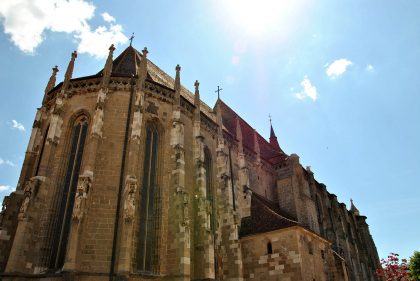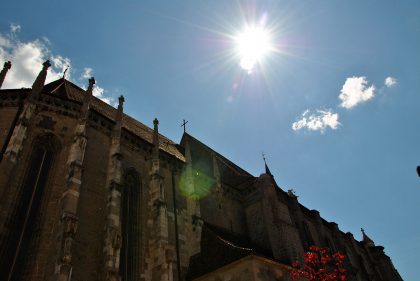
Tourism Brașov
Brașov (in German language Kronstadt) is one of the most visited cities in Romania by tourists. Thousands of people come here every year. Her beauty, charm and passion will leave you speechless.
It is a perfect and ideal place where you can spend your dream vacation carefree. Absolutely everything found in Brașov (in German language Kronstadt) takes our bliss to the highest peak. Castles full of history, museums where you can acquire culture and new knowledge. Ski slopes in winter and mountain hikes in summer, walks through the old town where you will find many shops and restaurants. All this means that everyone who visits this city will experience unforgettable moments.
Discover Brașov
Brasov, the Latin name Corona and in German Kronstadt which means “Crown City” is located in the center of the country and is one of the most visited cities in Romania.
A mixture of architectural styles give authenticity and brilliance to the city making it unique by the presence of Gothic, Baroque or Renaissance style buildings that annually attract thousands of tourists from all over the world.
Brașov (in German language Kronstadt) is the district capital of the district of the same name and consists of the towns of Brașov (in German language Kronstadt) and Poiana Brașov (German: Schulerau) and, with its 253,200 inhabitants, is one of the largest cities in the country. Poiana Brașov is located only 12 km from the city center and has a well-developed infrastructure for winter sports.
Brașov (German Kronstadt, Hungarian Brasso) was first mentioned in 1234, in the “Ninivensis Catalogue”, although its existence dates back to the Stone and Bronze Ages, as evidenced by the ancient settlements discovered in the Melcilor-Sprenghi region . The city was already 700 years ago an important connection point between Moldova, Transylvania and Wallachia because it is located between the great passes of the Carpathians: Bran, Predeal, Oituz and Buzäu. From September 8, 1959 to December 24, 1960 it was also called Stalin City and was the capital of the Stalin region. On February 17, it was declared the district capital.
Currently Brașov (in German language Kronstadt) is not only one of the most important economic, cultural and sporting centers of the country, but also an important tourist center and a city of monuments, such as Biserica Neagrä (German Black Church), the medieval city fortifications, the statue of Johannes Honterus, the town hall , Andrei Saguna Gymnasium and many others.
Tourist attractions
The Black Church
The church is located in the Old Town of Brașov (in German language Kronstadt), on the Town Hall Square, so you cannot miss it. We can only warmly recommend this wonderful tourist attraction as it is unique and full of historical significance in Romania. It is an Evangelical Lutheran parish church. The Black Church, in the 14./15. Built in the 19th century, it is one of the most important monuments of Gothic architecture in the country and, with a length of over 89 m, is also the largest church in Romania. The name comes from the great fire of 1689 that severely damaged the church and blackened its walls. Apart from the Topkapi Museum in Istanbul, the Black Church houses the largest collection of oriental carpets from the 15th and 16th centuries. Organ concerts have been held here since 1953, a tradition that began with organist Victor Bickerich and was later continued with Hans Eckart Schlandt. Every year domestic and foreign organists come here to give a concert in this wonderful place. Every summer there are organ concerts 3 times a week, a very good opportunity for visitors to enjoy the place and at the same time the inviting music.
The Council Square
The Council Square is of great importance, both for Brașov (in German language Kronstadt) and for Romania. It is one of the main attractions of the city and is visited by thousands of tourists every year. In the Middle Ages and in modern times, markets were regularly organized here and traders from all Romanian regions and from Hungary came here. Goods were taxed in front of the city gate, at the end of Customs Street, today Mureşenilor Street. From there you came directly to the town hall square. The justice of the peace and the city officials were responsible for enforcing order, so that every trader only displayed his goods in the places assigned by the city council. Today it is a special place to walk, with terraces, restaurants, museums, bookstores and shops both around and inside the market.
The White Tower
For a fantastic view over the whole old town, you have to come to this tower. Everything here seems magical and unreal and you will wish that time stood still. The White Tower was built between 1460 and 1494 and still impresses today with its massiveness and flowing lines. The tower has a semi-circular plan and a height difference of 30 m from the city walls, being 20 m high to the city and 18 m high to the hillside. The tower is crowned with battlements at the top, has four defensive bays on strong consoles and in the wall there are openings for bad luck. Inside the tower, only the chimney above the chimney has been preserved, which was probably also used to heat the guards and defenders. During the great fire in 1689, the White Tower was almost completely burned down and only restored in 1723. Further restoration work followed in 1902, 1947, 2002, 2005 and 2006 and today a museum is set up inside.
The Black Tower
The Black Tower is one of Brașov’s (in German language Kronstadt) four lookout towers and was built as an independent fortification outside the city walls. It is 11 m high. Construction of the tower started in the late 16th and early 17th centuries. The only entrance to the tower was at a height of 2 m above the ground and the tower was connected to the fortress by a drawbridge. The tower’s roof was originally built in the shape of a pyramid, but it was completely destroyed in 1559 after a strong lightning struck the tower. The fire in 1689 blackened its wall with soot, hence the name Black Tower. During the 1756 plague epidemic, the tower was last used as a shelter and base for the city’s defenders. The tower has suffered countless damages over time and has only been renovated in the last decade. In 2001 the Black Tower was opened to the public with a collection of 17th century weapons. Just like the White Tower, this tower is also one of the most important and enchanting sights of this region and definitely not to be missed.
Poiana Brașov (German Schulerau)
Poiana Brașov is the most beautiful and important place in the area, which attracts thousands of tourists every year. The place with its 12 ski slopes of different levels of difficulty is not only famous for winter sports, but also for its sports fields, clubs, restaurants and the lake. Poiana Brașov was founded in 1895 and was already used as a tourist resort at that time. The first log cabin was built in 1904, two years later Poiana Brașov was recognized as a winter resort and in 1909 the first Romanian ski competition was held. The place is at an altitude of 1030 m, at the foot of Mount Postävarul (German Schuler), which reaches a height of 1799.
If you haven’t visited the place yet, then you should do so soon and you won’t regret it. This beautiful area is the ideal place for a getaway where you can spend magical moments with your loved ones.

























